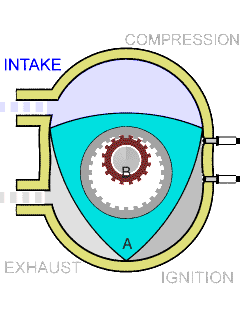
The Wankel KKM cycle:
- A: Apex of the rotor.
- B: The eccentric shaft.
- The white portion is the lobe of the eccentric shaft.
- The distance between A and B remains constant.
- Produces three power pulses each revolution of the rotor.
- Gives one power pulse per revolution of the output shaft.
The Wankel engine (/ˈvaŋkəl̩/, VUN-kell) is a type of internal combustion engine using an eccentric rotary design to convert pressure into rotating motion. The concept was proven by German engineer Felix Wankel, followed by a commercially feasible engine designed by German engineer Hanns-Dieter Paschke.[1] The Wankel engine's rotor, which creates the turning motion, is similar in shape to a Reuleaux triangle, with the sides having less curvature. The rotor spins inside a figure-eight-like epitrochoidal housing around a fixed-toothed gearing. The midpoint of the rotor moves in a circle around the output shaft, rotating the shaft via a cam.
In its basic gasoline fuelled form, the Wankel engine has lower thermal efficiency and higher exhaust emissions relative to the four-stroke reciprocating piston engine. The thermal inefficiency has restricted the engine to limited use since its introduction in the 1960s. However, many disadvantages have mainly been overcome over the succeeding decades as the production of road-going vehicles progressed. The advantages of compact design, smoothness, lower weight, and fewer parts over the reciprocating piston internal combustion engines make the Wankel engine suited for applications such as chainsaws, auxiliary power units (APUs), loitering munitions, aircraft, jet skis, snowmobiles, and range extenders in cars. The Wankel engine was also used to power motorcycles and racing cars.
- ^ "A Brief History of the Rotary Engine". rotaryrevs.com. Retrieved November 6, 2023.